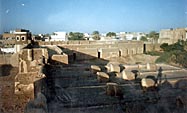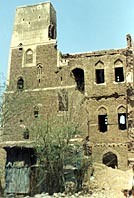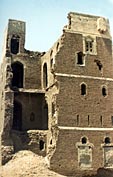
More Wonders from a Beautiful City The Forts and Walls of Zabid [Archives:1999/26/Culture]
June 28 1999
# 5 in a Series
The historical city of Zabid, whose name was associated with the civilization of the Yemeni people in ancient times, is still great. This city became famous for its culture, as well as for being a center of religious knowledge. It also had many great buildings, particularly the forts and walls, and these still survive today.

The historical city of Zabid was the capital of the Rasulid state in that time period. It was surrounded by walls, which were later on buried and remained hidden for many years. Other cities were built on top of the old cities, and the old slowly disappeared beneath the new.
The Yemeni civilization was based on the Tihama’s historical roots. This area had a great heritage, and many monuments that reflect the great civilization of the Yemeni people have been found. It has became a source of interest to many researchers around the world, because of its distinct artistic styles and unique construction.

In this episode I am going to examine another monumental aspect of the Tihama and its Al-Khartab city. This city is located on the ancient city of Al-Garahi, which was a very important place in its time, but is largely ignored today.
The city of Zabid was known through the ages for its culture and civilization, and its famous forts and palaces which were guarded against conquering armies by the walls surrounding the city on every side. The walls had four main doors to allow people to go in and out.
The first door was known as Al-Tabariq, and was located in the eastern part of the wall. It leads to Al-Hems and Al-Kariba town and the eastern valley of Zabid.
The second door was known as Gulaifiqah, located in the western part of the wall. It faces towards the valley of Zabid and the eastern town of Al-Tahitah.
The third door is known as Siham, and it opens out onto the main marketplace of of Zabid, and towards the Siham valley.
The fourth door was known as Al-Kartab. This door leads to the southern part of the Zabid valley, which was used as a means of communication between the two great cities of Zabid and Al-Khartab, a famous city that is located in the western part of Al-Garahi.

Because of the strength of this fort, it was a key strategic center for the Ottomans. It was the meeting place of the ruling government and the residence of the Ottoman governor.
The Ottomans lived in this area until the end of their rule over Yemen, when the area was controlled by the Imam and his son Ahmed Bin Hameed Aldien. It remained under their control until the 26th of September revolution, and it was not used again until 1970. At that point, it was given to the Ministry of Education, which transformed it to a school for Islamic teaching, and it was later given by the Sports Ministry in 1990. Since that time it has been ignored, which has lead to the destruction and decay of parts of the fort. However, there have recently been some efforts by the Antiquities Authority to repair the fort, in hopes that it could become an important tourist attraction in the Tihama.
By: Saleh Abdulbaqi
Cultural Editor
Yemen Times
——
[archive-e:26-v:1999-y:1999-d:1999-06-28-p:./1999/iss26/culture.htm]


